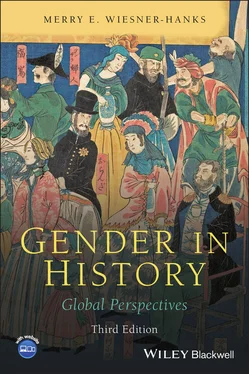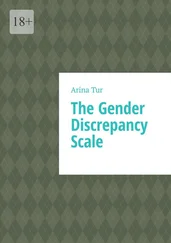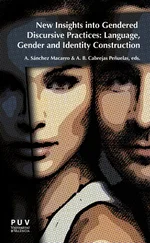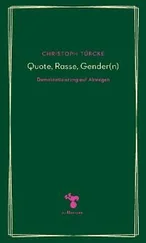Along with purity and honor, physical attractiveness is another dichotomous category that has been intimately shaped by, and in turn shapes, ideas and norms of gender. What characteristics make a woman or man attractive are, of course, highly variable both among cultures and among subgroups within a culture; some people would argue that beauty is so subjective that it is truly “in the eye of the beholder” and cannot be discussed at a more general level. This argument appears to be countered by the remarkable lengths to which people have gone throughout history to make themselves appear more desirable to themselves and others, or to conform to hegemonic standards of beauty. Cosmetics were common in many of the world’s earliest societies, and products that were thought to increase beauty or sexual appeal were traded across vast distances because they could bring a high profit. Cosmetics have been enhanced more recently by cosmetic surgery, with both of these in the modern world more often associated with women than with men, although this is changing. Particularly for women, purity, honor, and beauty have been linked in various ways; the directors of women’s protective shelters in early modern Italy, for example, explicitly limited the women they took in to those who were attractive, for, in their minds, ugly women did not need to fear a loss of honor and so did not merit protection.
Motherhood and Fatherhood
Just as it is easier to find information about women as a conceptual and legal category than about men, it is easier to find information about mothers and motherhood than about fathers. Many psychological theorists view one’s relation with one’s mother as the central factor in early psychological development, with some arguing that this is not culturally specific but innate. (Psychology has been criticized as a field, of course, for just this type of assertion.) Whether one accepts this view or not, the fact that women can become mothers has certainly shaped many of the laws and norms regulating women’s activities and behavior; what is usually referred to as the “sexual double standard” could more accurately be labeled the “parenthood double standard” (a phrase that might also be used to describe the realities of parenting in many households).
Though the possibility of motherhood has led to restrictions on women, motherhood has also been a source of great power, a much stronger and more positive role for a woman than being a wife. Many of the world’s religious traditions, including Hinduism, Confucianism, and Islam, view strong relations between mothers and sons as ideal, and interviews with contemporary people in societies as disparate as Jamaica, the Solomon Islands, and Japan have found that mothers are viewed as central to people’s lives while fathers are perceived as indifferent or distant. The power associated with the role of mothers has also been disturbing, however. Legal sources often refer to “wife of so-and-so” rather than “mother of so-and-so,” even in cases involving a woman’s relations with her own children, thus emphasizing a clearly dependent relationship rather than the one in which the woman has power over others. Stories and myths from many areas revolve around bad mothers, though because criticizing mothers directly is often viewed as unacceptable, the evil character is generally a stepmother or mother-in-law. Sometimes these myths affect the way real women are treated; in the witch trials of early modern Europe, for example, witches were often portrayed as bad mothers, killing or injuring children instead of nurturing them.
Nazi Germany and other European fascist regimes in the twentieth century provide excellent examples of the ambiguities of motherhood, and also of the ways in which motherhood has been used and manipulated symbolically. Nazi Germany itself was extolled as the “fatherland,” and Nazi leaders used hypermasculine imagery; their pronatalist movements were directed at fathers, not mothers, so as not to appear to grant women authority. “Motherhood” was celebrated in the abstract and medals awarded to women of the approved racial groups who had many children, but the power of husbands over their wives was also strengthened through various legal changes. Authoritarian regimes in Italy and Spain also passed pronatalist measures such as maternity or paternity bonuses and issued extensive propaganda seeking to make motherhood women’s only calling. The actual impact of these measures on birth rates and women’s employment rates was limited, however, and the regimes themselves toned them down by the 1940s when they needed women’s labor to carry out the war effort. More recent pronatalist measures such as tax preferences, cash grants, loan subsidies, and campaigns glorifying motherhood that various countries have adopted to try to increase their birth rates and reverse population decline have also not had much effect.
Similar disjunctures between the rhetoric and reality of motherhood can be found in many other places. Nineteenth-century Britain is often viewed as a high point of emphasis on maternity and domesticity for women; on closer investigation this turns out to have been an ideal limited only to middle-class women. In a country with two million nannies, few upper-class women actually mothered (or were expected to mother) their own children, while few lower-class women had the ability to spend much time on child care, as their lives were filled with factory or in-home labor. In colonial and more recent Latin America, women were encouraged to follow an ideal of seclusion, modesty, and devotion to their families termed marianismo after the Virgin Mary, the mother of Jesus, but poverty made this impossible for most women. Official propaganda in the Stalinist Soviet Union exalted motherhood as a patriotic duty and used motherhood as a metaphor for nationhood, but women were also expected to have full-time jobs and earlier institutions that had made their mothering easier such as communal kitchens were no longer supported by the state.
The rhetoric of motherhood itself has also been used in very different ways. Most often it has been used to urge women to stay out of the workplace and concentrate on family concerns, to become, as conservative Japanese authors recommended, “good wives, wise mothers.” Nineteenth-century reformers often used motherhood to argue for an expansion of women’s public role, however, stressing that education would make women better mothers. They asserted that having the vote would allow mothers to assure the well-being of their families and children, and to clean up corrupt politics in the same way that they cleaned up their households. Since the 1960s women in Latin America have protested the abduction and murder of their sons and husbands by various military dictatorships through public protests. The most famous of these, the Mothers of the Plaza de Mayo in Argentina, gathered weekly in the late 1970s and early 1980s, wearing white headscarves embroidered with the names of the “disappeared” and painting their silhouettes on walls. During Armenia’s 2018 “Velvet Revolution,” a largely peaceful protest that forced the resignation of the president, mothers took to the streets pushing baby strollers. In 2020, middle-aged women in Portland, Oregon wearing yellow shirts formed a “Wall of Moms,” linking arms to protest police violence in one of the many Black Lives Matter protests of that summer. Most of the women were white, but neither their privileged racial status nor their motherhood protected them, as federal agents fired tear gas and flash-bang grenades at them, just as they did at other groups of marchers.
Fatherhood has also been linked to politics and the exercise of power in both real and metaphorical terms. The words for “father” and “leader” are etymologically related in many languages, and the male originators of institutions and structures were often labeled “fathers” – the Church Fathers, the Founding Fathers. Hereditary monarchs such as kings, emperors, and czars were praised as the fathers of their people and used paternal language in their attempts to build or maintain their own power. They employed ideologies of kinship to mask their control over others, and hoped such language would encourage respect and obedience. Paternal rhetoric was also used, however, to criticize leaders for not living up to what was expected of a good father and could, in fact, become part of the language of revolution. Criticism of the French kings in the period leading up to the French Revolution often described them as bad fathers, not caring properly for their people; in the case of Louis XVI, the last king, he was also seen as too influenced by his queen Marie Antoinette, the archetypal bad mother whose lack of concern for her subjects was expressed in her (probably invented) comment to hungry people clamoring for bread – “let them eat cake.”
Читать дальше












